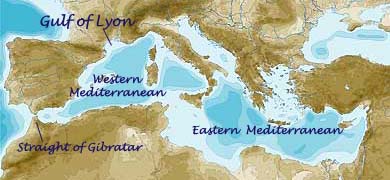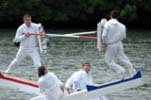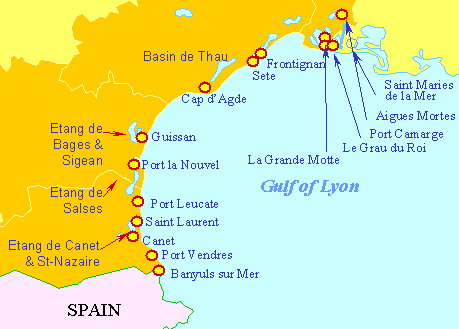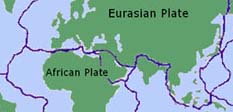
![]() The
Gulf of Lyon is a large bay in the Western Mediterranean
on the coast of the Languedoc-Roussillon
and Provence, reaching from the border with Spain in the
south to Toulon in the west. The continental shelf here
forms a wide coastal plain.
The
Gulf of Lyon is a large bay in the Western Mediterranean
on the coast of the Languedoc-Roussillon
and Provence, reaching from the border with Spain in the
south to Toulon in the west. The continental shelf here
forms a wide coastal plain.
The coastline is composed of sandy Mediterranean beaches along with lagoons and salt marshes and occasional rocky outcrops. Salt lakes (called étangs in the Languedoc) are common. The most notable salt marsh area at the mouth of the River Rhône is known the Camargue and is famous for its unique ecosystem.

![]() The
Mediterranean Sea was a transport superhighway in ancient
times, allowing for trade and cultural exchange between
the peoples of the region. It was critical to the development
of Western Civilisation and brought among others the Greeks,
Phoenicians,
Carthaginians,
and Romans
to the area around the Gulf of Lyon. According to some
stories it even brought Jesus' family to Saintes-Maries-de-la-Mer.
Arenas and theatres in the Gulf of Lyon are identical
to those all around the Mediterranean - Modern Turkey,
the Levant, Italy and North Africa all share a common
history with the Languedoc-Roussillon
and Provence.
The
Mediterranean Sea was a transport superhighway in ancient
times, allowing for trade and cultural exchange between
the peoples of the region. It was critical to the development
of Western Civilisation and brought among others the Greeks,
Phoenicians,
Carthaginians,
and Romans
to the area around the Gulf of Lyon. According to some
stories it even brought Jesus' family to Saintes-Maries-de-la-Mer.
Arenas and theatres in the Gulf of Lyon are identical
to those all around the Mediterranean - Modern Turkey,
the Levant, Italy and North Africa all share a common
history with the Languedoc-Roussillon
and Provence.
To the Romans the Mediterranean was Mare Nostrum (Latin, Our Sea). The name Mediterranean also derives from Latin mediterraneus, (medius, 'middle' & terra, 'earth') - for Romans as for other Mediterranean peoples it was literally the centre of the world. In Catalan it is the Mar Mediterrània. Food and wine also travelled across the Mediterranean. The Languedoc was the largest vineyard in the world in Roman times as it still is today. A spicy sausage called merguez is as popular in the Languedoc as it is in North Africa - its place of origin.

![]() Ancient
vestiges of distant Mediterranean practices remain too. Spanish and Languedocienne
bull
fighting is clearly a perfectly preserved hangover of Roman games. Bull
leaping in the Languedoc may well be older - an echo of Minoan religious
practices. Sea-water
jousting (Joutes Nautiques), still practised in the Languedoc at Sète,
Agde,
Béziers
and other towns, was first recorded in ancient Egypt.
Ancient
vestiges of distant Mediterranean practices remain too. Spanish and Languedocienne
bull
fighting is clearly a perfectly preserved hangover of Roman games. Bull
leaping in the Languedoc may well be older - an echo of Minoan religious
practices. Sea-water
jousting (Joutes Nautiques), still practised in the Languedoc at Sète,
Agde,
Béziers
and other towns, was first recorded in ancient Egypt.
The The House of Toulouse ruled not only the Languedoc, but another sovereign state in the Eastern Mediterranean, for the family of St Gilles were not only Counts of Toulouse but also Counts of Tripoli. Many crusades took sea routes through the Mediterranean. If King Richard I (Coeur de Lion or Lionheart) had not fallen out with the Count of Toulouse he would have been able to return safely to England from the Holy Land by way of the Western Mediterranean and the Languedoc or Provence and through his own Dukedom of the Aquitaine (instead of lurking around Europe in disguise - only to be captured by the Duke of Austria and having to pay 100,000 marks - literally a king's ransom - to secure his release).
The Mediterranean was also the medium by which the Occitan and Catalan languages were spread from the Languedoc and Catalonia (including the Roussillon) respectively. The Mediterranean was also important to many kingdoms, including the short-lived Kingdom of Majorca. Control of the Mediterranean was key to military success from ancient times to the present day. Hannibal brought his elephants across it to Spain before marching them through the Languedoc to the Alps.
Today, 22 modern states have a coastline on the Mediterranean Sea including France. In medieval times France had no Mediterranean coast until it annexed the territories of the Counts of Toulouse and the Viscounts of Carcassonne and Beziers following the Albigensian Crusade (the Roman Church's barbarous war against the Cathars of the Languedoc). Aigues Mortes was built by Louis IX (Saint Louis) as the first French Mediterranean port at the earliest opportunity after the annexation, and it was from there that he set off across the Mediterranean on his disastrous crusade to the Holy Land in 1248.
The Mediterranean Sea is connected to the Red Sea by the Suez Canal in the south-east and to the Atlantic Ocean by two different waterways. One is the Strait of Gibraltar in the west - a natural straight some 14 km (9 miles) wide. The other is the Canal du Midi which enters the Mediterranean at the port of Séte in the Languedoc-Roussillon. Completed in 1666 the canal is still an astonishing piece of engineering and now a world heritage site.
The Mediteranean Climate is generally one of mild winters and hot, dry summers. Typical crops of the area include cork, vines, sunflowers, olives, grapes, and (in the south) oranges and tangerines. The Provence area is famous for the Le Vent Mistral - an occasional blustery cold catabatic wind. Further south, the Marin brings humid weather inland from the Sea. Another wind, the Scirocco (or Sirocco), carries sand from the Sahara to the Langueoc.

![]()

![]() In
the last couple of generations the tourist industry has also taken off. Largely
along the littoral and concentrated around what were picturesque villages and
sandy beaches. Naturism
and nudism are well accepted - there is even a naturist village here - and
topless sun bathing is normal even on ordinary Languedoc beaches. Beach and water
sports include SCUBA
diving, sailing,
water
skiing, canoeing&
kayaking, wind
surfing, kitesurfing,
and sand yachting. The Mediterranean fishing industry in the
gulf is largely based on hake (Merluccius merluccius), The fish is bottom-trawled,
fished with long-lines and also gill-netted. As a result of over-fishing stocks
are declining. Other varieties fished commercially in the Gulf of Lyon include
sea bream, sea bass, mullet, mackerel, sardines, cuttlefish and flat fish such
as sole, turbot and brill. Farming of oysters, mussels and other shellfish in
the open sea is practised. There is also
sea fishing for tourists along the coast of the Languedoc.
In
the last couple of generations the tourist industry has also taken off. Largely
along the littoral and concentrated around what were picturesque villages and
sandy beaches. Naturism
and nudism are well accepted - there is even a naturist village here - and
topless sun bathing is normal even on ordinary Languedoc beaches. Beach and water
sports include SCUBA
diving, sailing,
water
skiing, canoeing&
kayaking, wind
surfing, kitesurfing,
and sand yachting. The Mediterranean fishing industry in the
gulf is largely based on hake (Merluccius merluccius), The fish is bottom-trawled,
fished with long-lines and also gill-netted. As a result of over-fishing stocks
are declining. Other varieties fished commercially in the Gulf of Lyon include
sea bream, sea bass, mullet, mackerel, sardines, cuttlefish and flat fish such
as sole, turbot and brill. Farming of oysters, mussels and other shellfish in
the open sea is practised. There is also
sea fishing for tourists along the coast of the Languedoc.

![]()

![]() The
chief port in the Gulf of Lyon is Marseilles. Rivers that
empty into the gulf include the Rhône,
Aude, Gard
(or Gardon), Hérault,
Têt,
Tech,
Orb
and Vidourle.
The
chief port in the Gulf of Lyon is Marseilles. Rivers that
empty into the gulf include the Rhône,
Aude, Gard
(or Gardon), Hérault,
Têt,
Tech,
Orb
and Vidourle.
In the last few centuries, humans have done a great deal of damage to the coast of Mediterranean in general and the Gulf of Lyon in particular. Buildings along the coastlines has exacerbated erosion. Pollution from motor boats has unbalanced the natural chemical equilibrium of the water. Beaches have been mismanaged, and the sea's natural marine resources have been overexploited. The natural geography of the area has been altered by the building of dams and canals - most notably in the Camargue which now has to be heavily "managed" by sea walls and constant pumping to maintain it in its unnatural state.

![]() Another
coastal industry is salt making - as for example in the
Camargue and at Gruissan
. Salt extracted from Mediterranean sea water is highly prized.
Another
coastal industry is salt making - as for example in the
Camargue and at Gruissan
. Salt extracted from Mediterranean sea water is highly prized.
Being almost landlocked, with just the Strait of Gibraltar linking it with the Oceans, the water of the Mediterranean Sea has distinct properties. One consequence is that Tides are very small - so that beaches are generally safe for swimming. Another consequence is that the entire circulation of the Mediterranean basin is regulated by water entering and leaving it in various ways. Water loss through evaporation exceeds precipitation and river runoff combined, bringing a net inflow of water through the Strait of Gibraltar. Evaporation is higher in its eastern half of the Med, causing the water level to decrease and salinity to increase eastward. This salinity gradient pushes relatively cool, low-salinity water from the Atlantic across the basin. (One consequence is that water flow is eastward on the Strait's surface waters, but westward below). Once in the open ocean, the chemically-distinct so-called Mediterranean Intermediate Water persists for thousands of kilometres away from the Strait of Gibraltar.
The Mediterranean Sea covers an approximate area of 2.5 million km² (965 000 miles²). It is almost completely enclosed: on the north by Europe, on the south by Africa, and on the east by Asia. It has an average depth of around 1,500 m. The deepest known point is 5267 meters (about 3.27 miles) in the Ionian Sea. The coastline extends for 46,000 km. A shallow submarine ridge between Sicily and Tunisia divides the Mediterranean into two, the Western Mediterranean (0.85 million km²) and the larger Eastern Mediterranean (1.65 million km².).

![]() The
Mediterranean is an ocean basin (called Neotethys) formed by the break up and
collision of the African and Eurasian plates during the Late Triassic and Early
Jurassic. The boundary between the African and Eurasian plates runs east-west
through the Mediterranean as shown on the right. The Gulf of Lion results from
the anticlockwise rotation of one tectonic area (Corsican-Sardinian Block) against
another (the European Craton) overlaying the mountain-building event in the Eocene
that was responsible for the Pyrenees mountains. There are thought to be untapped
oil deposits at the seaward margins of the gulf.
The
Mediterranean is an ocean basin (called Neotethys) formed by the break up and
collision of the African and Eurasian plates during the Late Triassic and Early
Jurassic. The boundary between the African and Eurasian plates runs east-west
through the Mediterranean as shown on the right. The Gulf of Lion results from
the anticlockwise rotation of one tectonic area (Corsican-Sardinian Block) against
another (the European Craton) overlaying the mountain-building event in the Eocene
that was responsible for the Pyrenees mountains. There are thought to be untapped
oil deposits at the seaward margins of the gulf.
Around 6 million years ago the late Miocene epoch the Mediterranean dried up - an event known as The Messinian Salinity Crisis. Around a million years later it flooded again presumably via the Strait of Gibraltar. As a result, the modern marine biology of the Mediterranean is derived primarily from the Atlantic Ocean. The North Atlantic is colder and than the Mediterranean, and the marine life adapted to the warmed less nutrient rich conditions in the five million years since the basin re-flooded. In recent times plants and animals from the Red Sea have begun to colonise the eastern Mediterranean. The Red Sea is generally saltier and poorer in nutrients than the Atlantic, so the Red Sea more rugged species tend to flourish in the Eastern Mediterranean at the expense of Atlantic species. This will, in time, affect the Western Mediterranean too, including the Golf of Lyon and the Languedoc coastal margin.
 Four
of the five departéments of the Languedoc-Roussillon
(Aude,
Gard,
Hérault,
Pyrénées-Orientales)
border the Gulf of Lyon. Only the Lozère
département has no Mediterranean
coast.
Four
of the five departéments of the Languedoc-Roussillon
(Aude,
Gard,
Hérault,
Pyrénées-Orientales)
border the Gulf of Lyon. Only the Lozère
département has no Mediterranean
coast.






